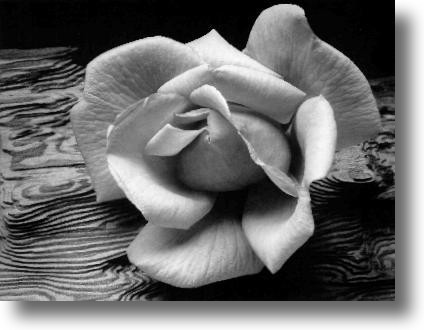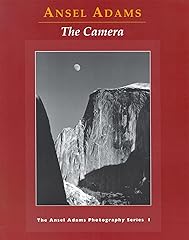Ansel Adams
Rose and Driftwood
San Francisco, California
c. 1932
A close-up "macro" photograph taken at the point in Adams life when he was making the final choice of a career in photography rather than in music.

The making of the picture
View price and framing optionsThis photograph was taken by Ansel Adams in his home in San Francisco. It was not a planned picture in that the two components came together fortuitously. His mother had brought in this large pale pink rose from the garden and presented it to her son, who being a photographer of course immediately wanted to take a picture of it!
The photograph was taken by the natural light coming from a north-facing window (north light)which gives an excellent subtle light for detailed objects and was perfect for the translucent petals of the rose. A problem was posed by the lack of a suitable background and Adams tried all manner of objects without success. Eventually he remembered this piece of wave-worn ply driftwood that he had picked up at a nearby beach. The design of the grain of the wood was a very pleasing setting to the similar shapes of the rose petals.
The picture was taken using a 4 x 5 in view camera, Adams was not yet as expert in exposure as he was to become and so he "bracketed" six exposures. That is he took the photograph six times with each being a slightly different exposure in order to get at least one of them just right. At such close focus, depth of field (the amount of the picture in sharp focus from front to back) was very limited and the lens was set at f/45 requiring a five second exposure, not in itself a problem however with still life subjects.
The picture is quite an early example and was made before Adams developed his idea of the "visualization" of a picture to include such refined details of the precise development of the negative to bring about the exact required image. Later in his career, the image was re-worked new prints being made of it on various papers and finally toning it with selenium to bring about the desired effect.
Adams was occasionally asked what it was that inspired him to make this picture. At the time it was taken, photography still hadn't been established as an art form in its own right and it was thought that a photograph should relate to some other similar picture from another art form. He said that he was not aware of being influenced by any other art form and certainly wasn't deliberately seeking to emulate.
Adams considered that such close up still-life pictures of natural objects that seem common place are actually of the unusual. Very little of our every day surroundings are subjected to close scrutiny. He recognized that the most commonly closely observed object was the printed page, still true now, but added to by the pixels on your computer monitor. Still today as then, "The small and commonplace are rarely explored".
This photograph was taken at a time of decision in Adams life, when he was deciding between a career in music or photography. He had just met the photographer Paul Strand, he along with another accomplished photographer Alfred Steiglitz and the f/64 group to which he belonged helped him make up his mind about career choice. Before the time of this photograph Adams had not photographed close-ups, the "macro" world of small objects clearly visible to the naked eye but rarely observed. After the time of this picture, he was to spend more time on such revealing details that can say as much about the natural world as his photographs of "distant grandeurs" - of soaring landscapes.
Rose and
Driftwood, by Ansel
Adams
View price and framing options
Bibliography- Examples: The Making of 40 Photographs by Ansel E. Adams






